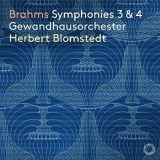Wenn Blomstedt und das Gewandhausorchester opulent in die Dritte Symphonie von Brahms einsteigen, hört man sofort hin, weil der Reichtum des Klanggeschehens auffällt und man Details hört, die sonst nicht so deutlich werden.
Auch im weiteren Verlauf der Symphonie bleibt jegliche Routine aus, Blomstedt belebt den Diskurs mit Rubato und Dynamik, und die Musik geht immer wieder so richtig in den Bauch. Das Andante wird mysteriöser denn je, das Poco Allegretto überschwänglich lyrisch und gefühlvoll. Das Tempo des letzten Satzes ist gemäßigt, aber weil es unterwegs so viel zu hören gibt, ist auch hier Hochgenuss angesagt.
Blomstedts Interpretation der Vierten Symphonie ist ebenfalls ein Musterbeispiel an Klangfülle, Detailreichtum und Ausgewogenheit im Klangbild.
Der erste Satz hat etwas Hymnisches, mit vielen jubilierenden Akzenten und zarteren, lyrischen Einschüben. Es ist faszinierend, was Blomstedt hier an Detailarbeit leistet, wie er strukturiert, Tonebenen einteilt, dabei eine schier unglaubliche Transparenz erreicht, feinste Abstufungen realisiert und jenen Grad der Loslösung vom Material erreicht, der nur dann zustande kommen kann, wenn ein Dirigent bis in den Kern der Musik vorgedrungen ist und gleichzeitig über ihr steht.
Blomstedt lässt das Orchester unvergleichlich geschmackvoll und schön, dabei immer spontan und lebendig musizieren. Der berückend lyrische zweite Satz ist genauso unvergleichlich nahrhaft wie der dritte mit seinem bezaubernd tänzerischen und quasi rustikal schwungvollen Frohsinn. Den letzten Satz gestaltet Blomstedt positiver als andere Dirigenten das getan haben. Er gibt ihm viel Kraft und Schwung und beendet so eine unglaublich erregende Vierte.
Schöner und beglückender als mit dieser Musik kann Musikhören nicht sein.
When Blomstedt and the Gewandhaus Orchestra opulently enter Brahms’s Third Symphony, one listens immediately because the richness of the sound is striking and one hears details that are not otherwise so apparent.
As the symphony progresses, too, any routine is absent; Blomstedt enlivens the discourse with rubato and dynamics, and the music really gets into your guts again and again. The Andante becomes more mysterious than ever, the Poco Allegretto exuberantly lyrical and soulful. The tempo of the last movement is moderate, but because there is so much to hear along the way, this is also high enjoyment.
Blomstedt’s interpretation of the Fourth Symphony is also a model of full sound, richness of detail and balance.
There is something hymn-like about the first movement, with many jubilant accents and more delicate, lyrical interjections. It is fascinating what Blomstedt does here in terms of detail, how he structures, divides tonal levels, achieves an almost unbelievable transparency, realizes the finest gradations and ultimately gets that degree of detachment from the material that can only come about when a conductor has penetrated to the core of the music and at the same time stands above it.
Blomstedt makes the orchestra play with incomparable taste and beauty, always spontaneous and lively. The enchantingly lyrical second movement is as incomparably nourishing as the third with its enthrallingly dance-like and quasi-rustic swinging cheerfulness. Blomstedt shapes the last movement more positively than other conductors have done. He gives it plenty of power and verve, so ending an incredibly exhilarating Fourth in a very good mood.
Listening to music can’t be more beautiful or more satisfying than with this music.
























